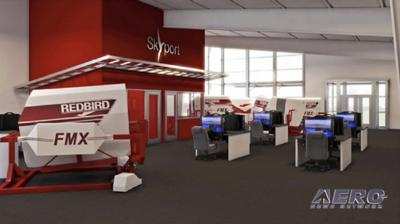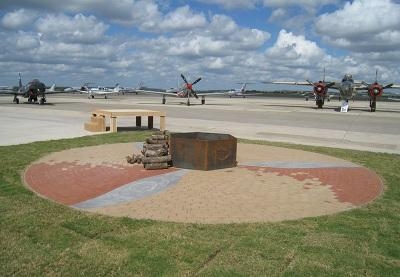Wed, Oct 24, 2012
Redbird’s Skyport Laboratory Creating Pilots In Two-Thirds The Time For Much Lower Cost
After one year of turning students into Private Pilots for a flat fee of $9500, Redbird Flight Simulation’s Skyport reports their experiment in simulator-based training is working. At its Migration Flight Training Conference this week, Redbird announced the school has graduated 20 Private Pilots, as well as completed 18 instrument ratings, one multi-engine rating and one instrument instructor certificate. It took an average of 38 flight hours to complete the private pilot rating, which is less than two-thirds the national average.

“We found that we needed to completely rethink the learner, the materials and delivery methods,” says Roger Sharp, Director of Flight Operations for the Skyport. Sharp says the Skyport and Redbird have 46 products that have come out of this process so far, with more on the way. “We identify better methods every week,” Sharp says of the simulator.
Some of these products are high-tech, such as a Guided Independent Flight Training or GIFT, which demonstrates maneuvers in the simulator and scores student performance on that maneuver automatically. Sharp points out that most instructors don’t enjoy teaching the basics in a simulator, so GIFT and the communications-training software Parrot automate the process until the student is ready to practice with live person watching. The instructor can be more a coach and mentor that a primary teacher, which suits most instructors better.
The Skyport has several low-tech solutions as well. Instead of the cinderblock-sized FAR/AIM study guide, Skyport students get slim study guides of key points. The 56 study items on VFR regulations fit into a 28-page book. “Not only can we reduce the amount of information the learner has to absorb, but we greatly increase their depth of understanding of important subjects at the same time,” says Sharp. Like the simulation tools and training aids, these products will be available to the public in the near future.
Given the pass rates and time to complete their certificates, the system seems to be working, but Skyport feels there’s plenty of room to do better. “We have months of work to refine our current methods,” says Sharp, “but there is much more we can study in this laboratory. It’s up to the industry to propose what that will be.”

Meanwhile, a roaring fire marked the opening evening for Redbird Skyport’s second annual Migration Flight Training Conference. The fire was in a “fire hub,” a creation of the Recreational Aircraft Foundation (RAF). The hubs are 22-foot-diameter circles lined with bricks and segmented by three 9-foot aluminum propeller blades radiating out from a central hub containing the fire.
RAF fire hubs are both practical and symbolic. “Since we do a lot of flying and camping, we think of a fire as the main gathering place for camaraderie and bonding,” says Tricia McKenna of the RAF. On the practical side, the fire hubs are fundraisers for the RAF to promote its efforts to promote recreational and backcountry aviation. Donors buy engraved bricks for $100 each from the RAF website and have them sent to the fire hub of their choice for installation. The hubs are financed by a local sponsor for $12,500 and are constructed and installed by RAF volunteers.
The inaugural fire hub was unveiled at Lakeland, FL, earlier this year. This is the second fire hub in a plan the RAF hopes will create at least 50 such fire hubs, one in every state. McKenna says that in addition to the Lakeland and San Marcos hubs, five others are in the works.
More News
Runway Lead-in Light System Runway Lead-in Light System Consists of one or more series of flashing lights installed at or near ground level that provides positive visual guidance a>[...]
Aero Linx: Aviation Without Borders Aviation Without Borders uses its aviation expertise, contacts and partnerships to enable support for children and their families – at hom>[...]
Dave Juwel's Aviation Marketing Stories ITBOA BNITBOB ... what does that mean? It's not gibberish, it's a lengthy acronym for "In The Business Of Aviation ... But Not In The Busine>[...]
From 2010 (YouTube Version): Yeah.... This IS A Really Cool Job When ANN's Nathan Cremisino took over the lead of our Aero-TV teams, he knew he was in for some extra work and a lot>[...]
Also: Junkers A50 Heritage, Montaer Grows, Dynon-Advance Flight Systems, Vans' Latest Officially, the Carbon Cub UL and Rotax 916 iS is now in its 'market survey development phase'>[...]
 ANN's Daily Aero-Term (04.24.24): Runway Lead-in Light System
ANN's Daily Aero-Term (04.24.24): Runway Lead-in Light System ANN's Daily Aero-Linx (04.24.24)
ANN's Daily Aero-Linx (04.24.24) Aero-FAQ: Dave Juwel's Aviation Marketing Stories -- ITBOA BNITBOB
Aero-FAQ: Dave Juwel's Aviation Marketing Stories -- ITBOA BNITBOB Classic Aero-TV: Best Seat in The House -- 'Inside' The AeroShell Aerobatic Team
Classic Aero-TV: Best Seat in The House -- 'Inside' The AeroShell Aerobatic Team Airborne Affordable Flyers 04.18.24: CarbonCub UL, Fisher, Affordable Flyer Expo
Airborne Affordable Flyers 04.18.24: CarbonCub UL, Fisher, Affordable Flyer Expo




